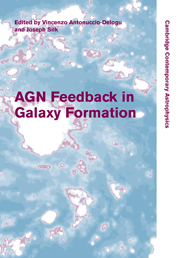Preface
Published online by Cambridge University Press: 10 November 2010
Summary
During the past decade, convincing evidence has been accumulated concerning the effect that AGN activity has on the internal and external environment of host galaxies. At intermediate and relatively high redshifts (z-0.2–1.5) evidence for this interaction comes, for example, from the optical–radio alignment and from the observation of jet-induced star formation. In the nearby universe there is also a series of significant indications: the observation of recent episodes of star formation in otherwise old or early types of ellipticals has emerged from analyses of the SDSS. There is also more direct and circumstantial evidence from the analysis of regions such as the Minkowski object, or the distribution of star-forming regions around the nearby radio envelope of Cen A, and from the enhanced star formation seen in some satellite galaxies of active galaxies at relatively high redshift.
Parallel and somewhat independently from this more direct evidence, the study of galaxy evolution has provided the astrophysical community with challenging new questions. The availability of large-scale photometric and spectral surveys such as the 2dF and the Sloan Digital Sky Survey has made it possible to discover evidence for evolution of the stellar formation features on timescales that are very short, in cosmological terms. The paradigm thus emerging in the astrophysical community is that AGN activity could be tightly connected to these phenomena, and could be capable of affecting the evolution of stellar populations within galaxies.
- Type
- Chapter
- Information
- AGN Feedback in Galaxy Formation , pp. xiii - xivPublisher: Cambridge University PressPrint publication year: 2010

